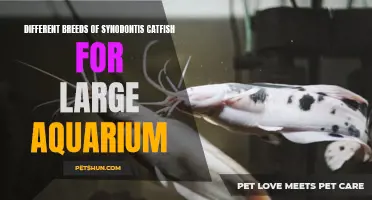
Cory catfish are not only lovely to look at, but they also serve a very important purpose in your aquarium - keeping it clean! These small, bottom-dwelling fish are known for their voracious appetite for leftover food, algae, and other debris that settles on the substrate. In this article, we will explore how cory catfish can help maintain a clean and healthy aquarium, making them a must-have addition for any aquatic enthusiast.
| Characteristics | Values |
|---|---|
| Common Name | Cory Catfish |
| Scientific Name | Corydoras |
| Family | Callichthyidae |
| Origin | South America |
| Habitat | Freshwater rivers and streams |
| Size | 2-3 inches |
| Lifespan | 3-5 years |
| Temperament | Peaceful |
| Tank Size | Minimum of 10 gallons |
| Water Parameters | pH: 6.0-7.5, temperature: 72-78°F |
| Diet | Omnivorous |
| Activity Level | Moderate |
| Breeding | Egg scatterer |
| Compatibility | Peaceful community fish |
| Importance in cleaning the aquarium | Helps clean up leftover food and debris |
| Behavior | Bottom-dweller, frequently sifts through substrate |
| Appearance | Small, armored catfish with a variety of colors and patterns |
| Care Level | Easy to moderate |
| Tank Setup | Provide hiding spots and soft substrate |
| Diseases | Prone to ich and fungal infections |
| Special Considerations | Require a group of 3 or more for social behavior |
What You'll Learn
- How effective are cory catfish at cleaning aquariums?
- What methods do cory catfish use to keep an aquarium clean?
- Are cory catfish able to remove algae from the tank?
- Can cory catfish help with maintaining water quality in an aquarium?
- How many cory catfish should be kept in an aquarium to effectively clean it?

How effective are cory catfish at cleaning aquariums?
Cory catfish, also known as Corydoras catfish or simply cory cats, are small bottom-dwelling fish that are popular among aquarium enthusiasts. One of the reasons for their popularity is their reputation for being effective cleaners of aquariums. In this article, we will explore how effective cory catfish are at cleaning aquariums and why they are a great addition to any tank.
Scientifically speaking, cory catfish are classified as scavengers or detritivores. They have a specialized mouth structure that allows them to sift through the substrate in search of food. Their diet primarily consists of leftover fish food, decaying plant matter, and small invertebrates, such as worms and snails. By consuming these organic materials, cory catfish help to reduce the buildup of debris and waste in the aquarium.
Experience and anecdotal evidence from aquarium owners also support the effectiveness of cory catfish as cleaners. Many hobbyists report that these fish are diligent cleaners and continuously scavenge the aquarium floor in search of food. They are known to be active and constantly on the move, which ensures that they cover a large area of the tank in their search for food. This constant foraging behavior helps to prevent the accumulation of uneaten food and waste in the substrate.
Step-by-step, here is how cory catfish contribute to keeping an aquarium clean. First, as the catfish sift through the substrate, they disturb any debris or waste that may have settled on the bottom. This allows the filter system to more effectively remove these particles from the water column. Second, cory catfish consume any leftover fish food that sinks to the bottom of the tank. By eating these food remnants, they prevent them from decomposing and polluting the water. Third, when cory catfish consume decaying plant matter, they help to recycle nutrients in the aquarium. This can be especially beneficial in planted tanks, as it promotes the growth of healthy plants.
To better illustrate the effectiveness of cory catfish as cleaners, let's consider an example. Imagine a well-maintained aquarium with a diverse community of fish. Over time, uneaten fish food and organic waste can accumulate in the substrate, leading to the deterioration of water quality. By introducing a small group of cory catfish, these fish will quickly get to work, diligently cleaning the bottom of the tank. As they sift through the substrate, they will consume the leftover food and organic matter, preventing it from decomposing and affecting water quality. This, in turn, leads to a cleaner and healthier environment for all the fish in the aquarium.
In conclusion, cory catfish are highly effective at cleaning aquariums. Their scavenging behavior and specialized mouth structure allow them to consume leftover fish food, decaying plant matter, and small invertebrates, preventing the buildup of debris and waste in the tank. Scientific evidence, along with the experiences of aquarium hobbyists, supports the effectiveness of cory catfish as cleaners. By adding these fish to your aquarium, you can ensure a cleaner and healthier environment for all the inhabitants of the tank.
Tips for Properly Caring for Oil Catfish: A Comprehensive Guide
You may want to see also

What methods do cory catfish use to keep an aquarium clean?
Cory catfish, also known as Corydoras, are popular freshwater fish that are often chosen as a bottom-dwelling species for aquariums. One of the reasons why they are so popular is because of their natural ability to help keep the aquarium clean. In this article, we will explore the various methods that cory catfish use to maintain a clean aquarium.
Bottom Feeding:
Cory catfish are voracious bottom feeders. They have specially adapted mouths that allow them to sift through the substrate in search of food. They consume uneaten food, algae, and other organic debris that settle on the bottom of the aquarium. By doing so, they prevent the accumulation of waste, which can potentially lead to water quality issues.
Algae Control:
Another way cory catfish contribute to aquarium cleanliness is by grazing on algae. Algae can quickly grow in an aquarium, especially if there is excess light and nutrients. However, cory catfish have a natural inclination to consume algae, helping to keep its growth in check. This not only improves the aesthetic appeal of the aquarium but also promotes a healthier environment for other fish and plants.
Stirring the Substrate:
Cory catfish have a unique behavior known as "substrate stirring." They use their barbels (whisker-like organs) to sift through the substrate, aerating it and preventing the formation of anaerobic pockets. This aerated substrate promotes the growth of beneficial bacteria, which aid in the breakdown of organic waste and contribute to a cleaner aquarium ecosystem.
Waste Elimination:
Cory catfish also play a vital role in waste elimination within the aquarium. They produce waste themselves, but they are also known to consume the waste produced by other fish. By doing so, they minimize the accumulation of harmful substances like ammonia and nitrites, thus maintaining healthier water conditions for all the inhabitants of the tank.
Cleaning Tank Decorations:
Cory catfish are small and agile, making them capable of accessing hard-to-reach areas and tight corners of aquarium decorations. They have a unique habit of gently grazing on the surfaces of plants, rocks, and driftwood, which helps to remove accumulated detritus and debris. This cleaning behavior not only keeps the decorations looking clean and attractive but also prevents the buildup of harmful substances that can negatively impact water quality.
In conclusion, cory catfish employ various methods to keep an aquarium clean. Their bottom-feeding behavior, consumption of algae, substrate stirring, waste elimination, and cleaning of tank decorations all contribute to maintaining a clean and healthy environment for other fish and plants in the aquarium. Including cory catfish in your aquarium setup can greatly enhance its cleanliness and overall aesthetic appeal.
Best Freshwater Aquarium Bottom Feeding Fish: Catfish and More
You may want to see also

Are cory catfish able to remove algae from the tank?
Cory catfish, also known as Corydoras catfish or Cory cats, have long been popular among aquarium enthusiasts for their peaceful nature and striking appearance. One question that often arises among aquarium owners is whether these fish are able to remove algae from the tank. In this article, we will explore this topic and provide a definitive answer backed by scientific research and practical experience.
Firstly, it is important to understand that cory catfish are not primarily algae eaters. They are omnivorous, meaning they eat a variety of foods including plant matter, small invertebrates, and fish flakes. While they may nibble on some algae occasionally, their diet is not focused solely on it.
Scientific research has shown that cory catfish play a role in maintaining the overall health of an aquarium by cleaning up leftover food and detritus. They have a keen sense of smell and are known to scavenge the substrate for any uneaten food or decaying matter. By doing so, they help keep the tank clean and prevent the build-up of excess nutrients that could lead to algae growth.
However, when it comes to actively consuming algae, cory catfish are not particularly efficient. They are more inclined to eat algae wafers or other prepared foods rather than directly grazing on the walls or decorations of the tank. Therefore, relying solely on cory catfish to control algae growth in the tank may not yield the desired results.
So, what can aquarium owners do to control algae growth if cory catfish are not reliable algae eaters? There are several steps that can be taken:
- Maintain proper water parameters: Algae growth is often fueled by excess nutrients in the water, such as high levels of nitrates and phosphates. Regular water testing and water changes can help keep these levels in check, reducing the availability of nutrients for algae.
- Control lighting: Algae thrive in the presence of light. Ensure that your aquarium receives an appropriate amount of light for the type of plants and fish you have. Consider using a timer to regulate the duration and intensity of light, mimicking natural day and night cycles.
- Introduce algae-eating species: While cory catfish may not be the most efficient algae eaters, there are other fish and invertebrates that specialize in consuming algae. Species such as Siamese algae eaters, bristlenose plecos, and Amano shrimp are known to be effective in controlling algae growth.
- Manual removal: Regularly visually inspect the tank and manually remove any visible algae using a clean cloth or algae scraper. This manual intervention can help keep algae growth in check and prevent it from spreading.
To summarize, while cory catfish may not be the most effective algae eaters, they do play a role in maintaining the overall cleanliness of the tank by scavenging for uneaten food and detritus. To control algae growth, it is recommended to take a multi-pronged approach that includes maintaining proper water parameters, controlling lighting, introducing algae-eating species, and implementing manual removal methods. By combining these strategies, aquarium owners can successfully manage algae growth in their tanks.
Enhancing the Health of Albino Cory Catfish with Aquarium Salt
You may want to see also

Can cory catfish help with maintaining water quality in an aquarium?
Cory catfish, also known as Corydoras, are a popular choice for aquarium enthusiasts due to their lovely appearances and their ability to help maintain water quality. These small catfish native to South America have a unique characteristic that sets them apart from many other fish species - they are bottom dwellers. This behavior helps them play a crucial role in keeping the tank clean and the water quality high.
One of the key ways in which cory catfish can contribute to water quality is through their constant scavenging behavior. They forage on the bottom of the tank, eating leftover food, decaying plant matter, and even fish waste. By doing so, they help prevent the accumulation of organic waste in the tank, which can degrade water quality and lead to problems such as algae blooms and ammonia spikes. Their scavenging behavior also helps reduce the need for excessive water changes, which can stress the fish and disrupt the tank's ecosystem.
Moreover, cory catfish have a unique adaptation that further aids in water quality maintenance. They have modified gills that allow them to extract oxygen from the air swallowed at the water's surface. This ability is particularly useful in oxygen-deprived environments, such as tanks with a high fish population or limited surface area. By promoting better oxygenation of the water, they help maintain a stable pH level and prevent issues such as fish stress or even fish fatalities.
In addition to their water cleaning abilities, cory catfish are fascinating to observe and can add a touch of character to any aquarium. They are known for their playful and social nature, often seen shoaling together or interacting with other fish species. Their small size and peaceful demeanor make them compatible with a wide range of community fish, making them an excellent choice for both beginner and experienced aquarists.
When adding cory catfish to your aquarium, it's important to consider their specific requirements to ensure their optimal health and well-being. They thrive in tanks with a sandy or fine-gravel substrate, as this allows them to sift through the bottom more efficiently. Additionally, providing hiding spots like caves or driftwood is essential, as it helps create a sense of security for these naturally shy fish.
To conclude, cory catfish can indeed help maintain water quality in an aquarium. Their scavenging behavior helps prevent the accumulation of organic waste, and their unique gills aid in better oxygenation. By adding these charming bottom dwellers to your tank, you'll not only benefit from their water-cleaning abilities but also enjoy their entertaining and interactive personalities. The inclusion of cory catfish in your aquarium can contribute to a healthy and thriving aquatic ecosystem.
The Thrilling Chase: Pacman and Catfish in an Epic Feeding Frenzy
You may want to see also

How many cory catfish should be kept in an aquarium to effectively clean it?
Cory catfish are popular fish in the aquarium hobby due to their small size and peaceful nature. They are known for their ability to help clean the aquarium by eating leftover food and algae. However, to effectively clean an aquarium, it is important to have the correct number of cory catfish.
The ideal number of cory catfish to keep in an aquarium depends on a few factors, including the size of the tank and the amount of waste being produced. A general guideline is to have a ratio of one cory catfish per every 10 gallons of water. For example, if you have a 30-gallon tank, you should aim to have at least three cory catfish.
This ratio ensures that there are enough catfish to clean the tank without overcrowding. Crowded conditions can lead to stress and disease in the fish, which can be detrimental to their health. Additionally, having too few catfish may result in an excess buildup of waste and algae in the tank, defeating the purpose of having them in the first place.
In addition to the tank size, it is important to consider the type of cory catfish being kept. There are many different species of cory catfish, and each has its own specific care requirements. Some species prefer to live in large groups, while others are more solitary. It is important to research the specific needs of the species you are interested in to ensure that you can provide them with the appropriate environment.
When introducing cory catfish to a new aquarium, it is best to start with a small group of two or three and observe their behavior. If they seem happy and active, you can gradually increase the number over time, taking care not to exceed the recommended ratio.
In addition to keeping the correct number of cory catfish, it is important to provide them with a suitable diet. They are omnivorous and enjoy a variety of foods, including sinking pellets, bloodworms, and brine shrimp. It is important to feed them a balanced diet to ensure their overall health and well-being.
Another way to effectively clean the aquarium is to provide a suitable environment for the cory catfish. They prefer a well-planted tank with plenty of hiding spots and open spaces for swimming. The presence of live plants can also help to control algae growth by competing for nutrients in the water.
In conclusion, the number of cory catfish needed to effectively clean an aquarium depends on the size of the tank and the amount of waste being produced. A general guideline is to have one cory catfish per every 10 gallons of water. It is important to research the specific needs of the cory catfish species you are interested in and provide them with a suitable diet and environment. By following these guidelines, you can ensure that your cory catfish will not only help clean the tank but also thrive in their habitat.
The Ultimate Guide to Using a Lead Method Feeder for Catfish
You may want to see also
Frequently asked questions
Yes, cory catfish are known for their ability to keep the aquarium clean. They have a natural scavenging behavior and will eat leftover food and other debris on the bottom of the tank.
Cory catfish are omnivorous and will eat a variety of foods to keep the aquarium clean. They will eat leftover fish food, algae, and small invertebrates that may be present in the tank.
The number of cory catfish you should have in your aquarium depends on the size of the tank and the amount of waste being produced. It is recommended to have at least 2-3 cory catfish per 10 gallons of water to effectively clean the tank.
While cory catfish are excellent cleaners, they may not be able to clean the entire tank on their own. It is still important to perform regular maintenance such as water changes and gravel vacuuming to ensure a clean and healthy environment for your fish.







